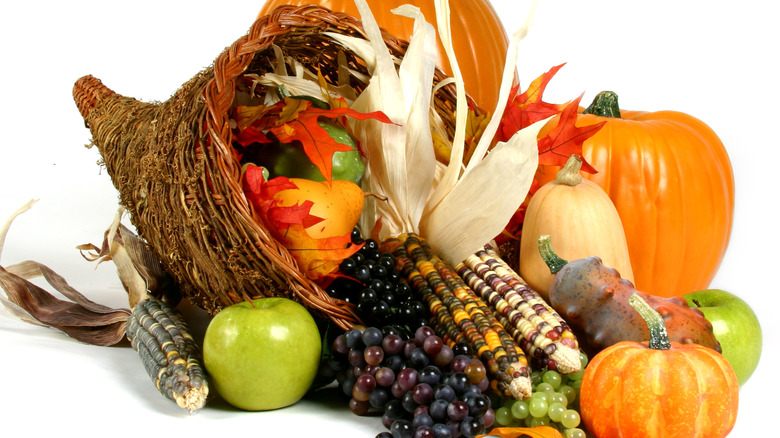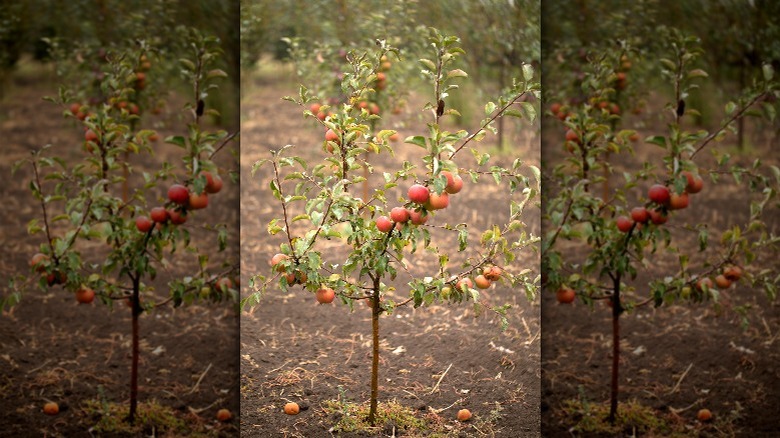The US Wouldn't Have Apples Without Pilgrims
They say nothing's more American than apple pie, but what's now the United States of America didn't even have apples (as we know them today) until the Pilgrims brought them across the Atlantic. In 1620, about a hundred Puritans seeking religious freedom and cultural autonomy arrived upon the Mayflower at the modern-day Cape Cod Bay of Massachusetts — around where Indigenous Americans such as the Wampanoag people had lived for thousands of years.
One decade later, roughly a thousand religious refugees from England followed suit and established the nearby Massachusetts Bay Colony, where roots of the U.S. apple industry would be planted.
It should be noted: In the 1500s, French Jesuits brought apple seeds to North America, and it's thought Jamestown — the first English settlement on the continent — could have featured apples, too. Nevertheless, the first documented apple shipment of seeds in what would eventually become the United States were planted at Massachusetts Bay Colony. This trend would not end with the Pilgrims, though, who initiated a whole wave of apple cultivation in their area.
Colonists from Europe continued to introduce apples to the East Coast. Back then, processed apples (butter, cider, vinegar, etc.) were more often used than fresh ones. Indigenous Americans also traded with the Pilgrims, receiving their own apple seeds to plant and cultivate, which helped move the crop farther west.
How did England get apples?
The United States owes England for its apples, but apples did not originate in Great Britain. Domestic apples hail from the forests of Central Asia's Tien Shan mountains, stretching back thousands of years. Wild apples had been used for cider production across Eurasia as far back as the Stone Age, but it was there — somewhere around modern-day Kazakhstan — where humans first started planting apples of good quality for future use. Later on, people began breeding the crop to increase desirable traits, creating something closer to the apples we enjoy today.
Nomadic cultures of the Asian Steppe carried apples over stretches of land that would someday match up with the Silk Road. Thanks to those caravans, the domesticated crop gradually made its way into Europe, as well as the Middle East, picking up new traits from other wild apples along the way.
Some of the earliest fossils of European domesticated apples have been found in ancient Ireland, Italy, and Switzerland. Regardless, by 800 B.C., ancient Greece started actively cultivating apples. The Romans would later adopt that practice and bring apples with them to Great Britain, while growing their own empire via colonies.
Consequently, there were well over a hundred different apple varieties in Europe by the time the Columbian Exchange started. Colonization brought many of them to North America, where Indigenous Americans and Europeans furthered the reach of this crop. By 1776, sweet apples were already well established in the United States.
What is an American apple?
When talking about wild apples, they're known as crabapples — tart little fruits that belong to the same family as apples. Crabapples have their uses, such as making butter or jelly with the addition of lots of sugar, or yielding juices that are added to condiments. Breeders look to crabapples when searching for new traits to lend their apples, as well. Crabapples also feed livestock and decorate gardens. Still, they frequently taste bitter, limiting their popularity.
Despite this, they're widespread, native as far east as Asia, and as far west as North America. Indeed, the Pilgrims found that the New World already had crabapples when they arrived; they just weren't appetizing to them. Some Indigenous Americans, meanwhile, ate cooked crabapples and employed the trees' bark in their medicine. When looking at U.S. apples, it's worth mentioning that we specifically mean the sweet species, which was domesticated in the Old World. It's also worth mentioning that native American apples do exist, loosely speaking.
Given modern palates, many can likely appreciate that apple orchards in America primarily deal with apples — not crabapples. One group, the Bassetlaw District Council in the United Kingdom, at least recognizes the historical significance of all this. Back in 2020, it sent a new variety of apple known as the "Pilgrim Apple" to Cape Cod, MA, where it was planted to mark the 400th anniversary of the Pilgrims arriving in that region.


